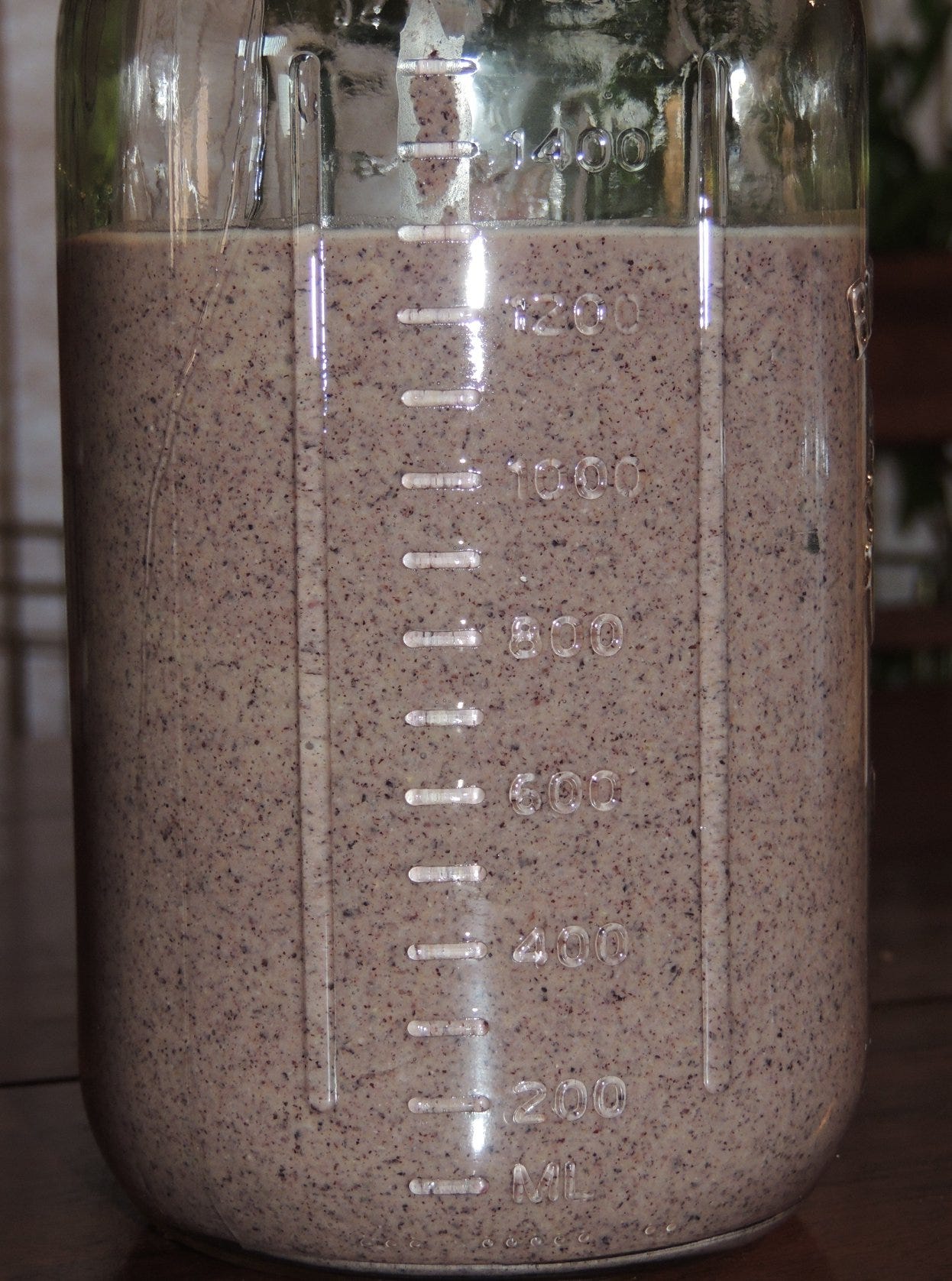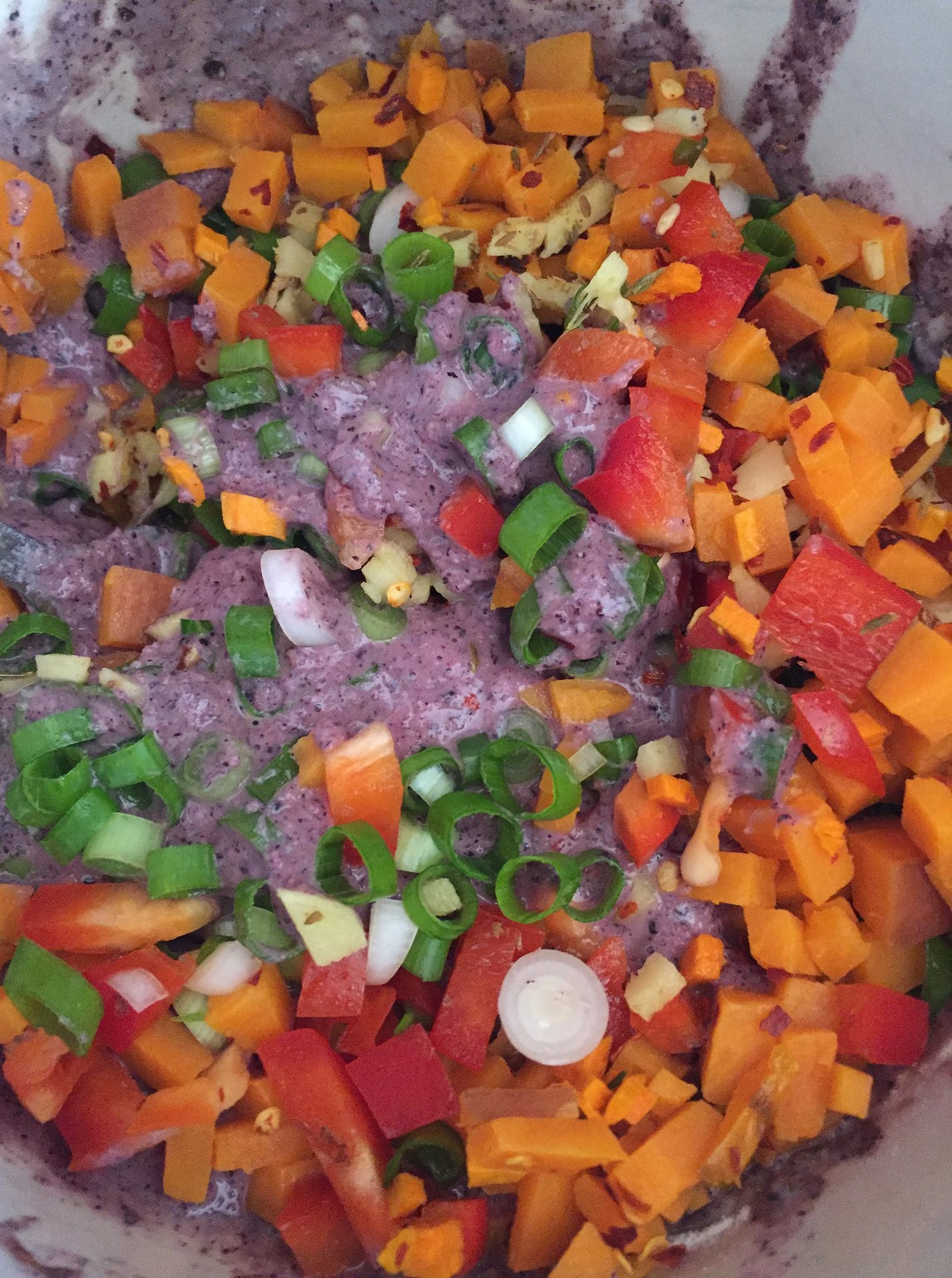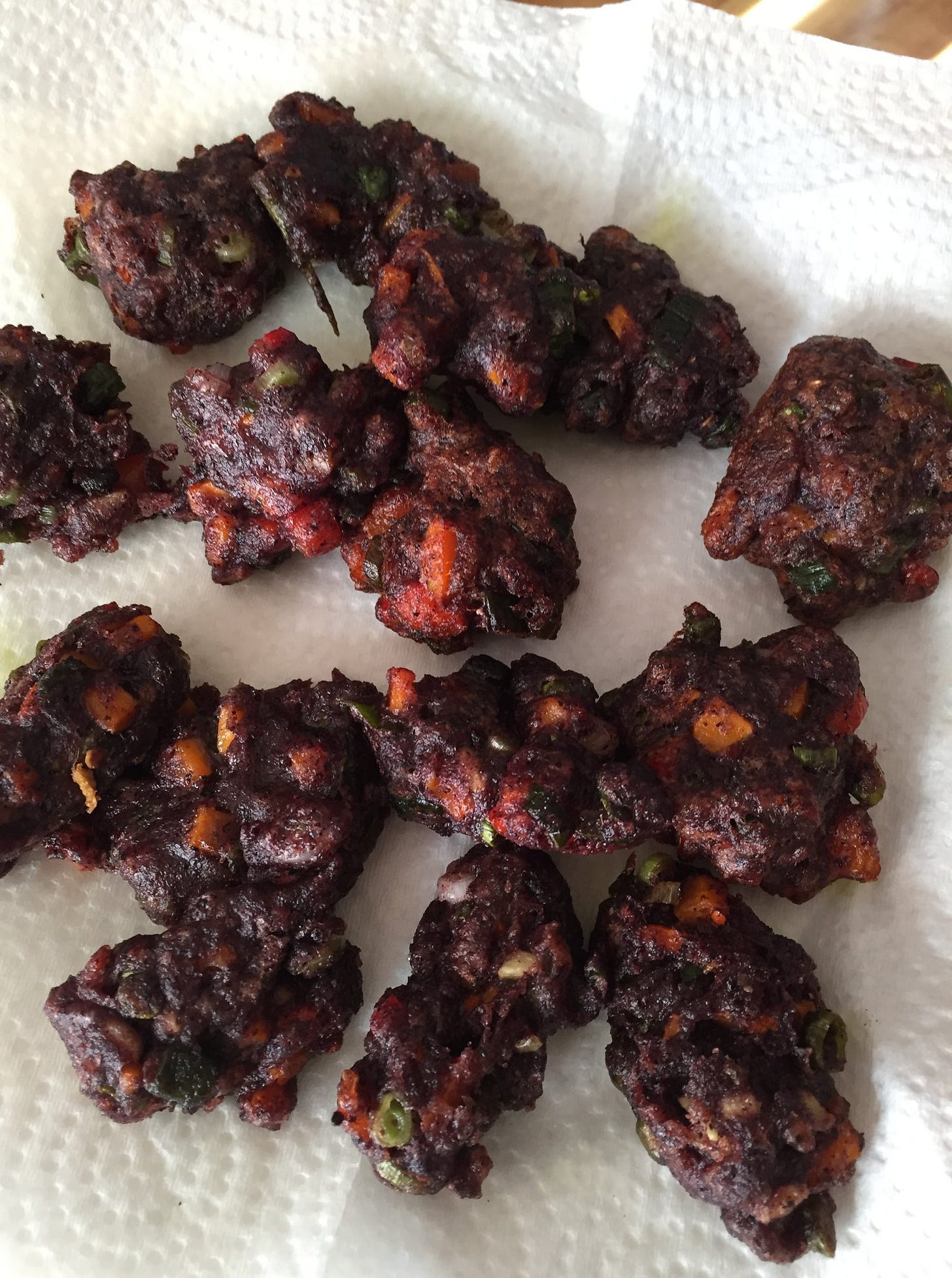Wild Rice / Amarnath Seed Dosa Batter and Purple Pakoras
This recipe is one of my favorite ways to enjoy our Amaranth harvests combined with wild rice harvested by indigenous wisdom keepers from our local region
I created a fermented wild rice, lentil and amaranth batter (which was originally intended to be used for making a kind of Indian flat bread called Dosa) but ended up experimenting and discovering some other amazing uses for the batter (which I now like even more than dosa bread).
While the Purple Dosa flat bread that I made in the first batch was indeed delicious, I did not use the best pan, nor an ideal spatula (and on top of that my crepe flipping skills leave much to be desired) and so I only managed to get a few of them off the pan in one piece (next time I will be better prepared).
I ended up experimenting with using the left over batter to do something similar to Tempura where I battered chunks of veggies and then deep fried them. I also did a variation on another Indian food called Pakoras.
I diced up veggies, herbs, and spices and mixed them into some of the purple Dosa batter and then scooped a tablespoon at a time or so out and deep fried to make these mind blowingly delicious and nutritious fritters. I added things like diced ginger and fermented turmeric, sweet potato and green onions.
I used coconut and avocado oil and fried the pakoras in small batches. I have to say this is now officially in my top 5 favorite foods of all time. By the second day of fermentation (when i used the left overs to make the pakoras) the purple dosa batter had a very distinct and complex flavor, it was tangy and full of interesting layers.

For this batch we used black ("forbidden") rice, wild rice (here is one great local source), mahogany rice, red lentils, split peas and amaranth seed to make our batter.

After soaking and blending everything, it turned out a lovely purple color (due to the anthocyanin in the black rice). After it began spontaneously fermenting (fermenting via the action of native lactic acid bacteria) in a big jar the batter rose very quickly. I added the batter to a 2 litre jar and filled about 2/3 full but this fermenting batter was so active that it burst out of the top of the jar at one point and I had to pour some into a bowl to finish fermenting a rising.
This form of preparing rice is especially beneficial because of it's ability to remove toxins and anti-nutrients from the rice (and other ingredients). Rice has the unfortunate ability of very effectively pulling arsenic out of contaminated waters/soils (and since humans do not have a very great track record for treating the Earth with respect) much of the rice available on the market today has pretty high levels of arsenic in it.
The process of making Dosa batter is helpful for removing the arsenic in rice (and also effective at removing the anti-nutrients present in the rice bran). The process involves soaking (beginning to sprout), rinsing, grinding into a batter, fermenting the batter (much like sourdough) and cooking the fermented batter before eating. This process removes most of the arsenic and also removes 96% of the anti-nutrients like lectins and phytase (phytic acid) which are plant compounds that can interfere with the absorption of minerals like calcium, iron, zinc, phosphorus and magnesium.
In many cases people plan their vegetables around their available or preferred protein/carb choices.. this meal turns that on its head literally surrounding the veggies with protein, carbs and healthy fats. The minerals and anti-oxidants present in the batter are also significant, now cover some nutritious veggies with that fermented batter and fry in coconut or avocado oil and you have your self a delicious finger food that covers all the nutritional bases!
INGREDIENTS:
2 cups rice (I used a mixture of black ("forbidden") rice, wild rice and mahogany rice)
2 cups legumes and/or protein rich seeds (I used a combination of organic red lentils, split peas and homegrown amaranth seed for ours)
1 tsp. fenugreek seeds
2 tsp. sea salt
Water as needed
coconut oil
Optional ingredients:
1/2 cup grated fresh coconut
1 tsp hot chili flakes
other herbs of spices of choice
1 tsp of finely diced turmeric rhizome
1 tsp of finely diced ginger rhizome
INSTRUCTIONS:
Soak rice in a medium vessel, covered with water by a couple of inches, for 6 to 8 hours. In another container, simultaneously soak lentils and fenugreek seeds, covered with water by at least 3 inches, for 6 to 8 hours.
After the soaking process is complete, drain and rinse rice and lentils/fenugreek seeds separately.

You are now going to be grinding the two elements, separately to achieve the right consistency, in a food processor or blender.
Start by adding a couple of tablespoons of water to the grinder, followed by a handful of the lentils. Grind until fluffy and smooth, much like marshmallow fluff, in small batches adding handfuls of lentils and a couple of tablespoons of water at a time. This may take 15 minutes or so. Transfer lentil batter to a separate, very large vessel being careful not to remove too much air from the batter.
Repeat with rice, but this time aim for a slightly gritty batter as opposed to the smooth batter of the lentils. Start by adding one cup of water to the machine then handfuls of rice at a time, with additional water to facilitate the grinding of the rice. This may take 20 or so minutes.

mixing the blended rice into the Split pea, Golden Giant Amaranth seed and red lentil batter Carefully transfer rice batter to the vessel containing lentil batter, again being careful not to remove air trapped in batter. Add salt and carefully mix the two batters with a clean hand or large spoon. Taste and add additional salt if the batter tastes flat. Be sure that the vessel has room for the batter to double in size. If not, pour half the batter into a separate vessel to allow room for expansion.
Cover with a breathable lid such as a clean towel and secure to keep fruit flies out. Place in a warm spot such as an oven with a pilot light on, or atop a warm refrigerator.
Ferment for 12 to 48 hours, depending on the temperature, or until batter appears to have doubled.
Once fermented, the dough should be frothy and of pouring consistency, but not runny. If it is not of pouring consistency, add a little bit of water and stir very gently, being sure not to deflate dough. Save some batter for making Dosa bread and some for Pakoras
Preheat a 10-inch cast-iron skillet over high heat and allow the pan to heat up. Once you feel warmth coming off of it when you place a hand just above the bottom of the pan, test it by sprinkling a few drops of water on the bottom of the pan. If the water evaporates within 4 seconds it is ready.
Oil half of a small onion on the cut side. Stab onion with a fork and move onion all around skillet to oil the pan.
Ladle 1/4 cup of batter into the hot pan. With as little pressure as possible, use the back of your (metal) ladle to swirl the batter in concentric circles to fill the pan.
When the batter is spread, drizzle a few drops of olive oil over the dosa in the pan.
Cook over medium-high heat until the bottom is lightly brown. Now roll or fold the dosa out of the pan. There is no need to cook the other side unless you like a crisper dosa.
Serve with Indian chutney, curry, or a bean dish.
Purple Pakoras (made with left over Dosa Batter)
Pakoras are one of my all time favorite snacks. If make it with a left over Dosa batter it serves the dual purpose of not wasting the left overs and when combined with nutrient dense ingredients and cooked in coconut oil, it can serve as a nutritionally valuable meal item. You can coat veggies in this batter to make amazing Tempura like snacks or you can diced a range of ingredients to make super flavorful Purple Pakora clusters.
Ingredients for the Pakora Clusters:
1-2 cups left over Dosa Batter
1/2 tsp Cumin seeds
1/2 tsp Ginger (Finely chopped)
2 hot chilies (Finely chopped)
2 tbsp Grated Coconut
2 tbsp Coriander leaves (Finely chopped)
1/2 Green Onion (Finely chopped)
1/2 cup diced bell pepper
1/2 cup diced shiitake mushrooms
1/2 cup diced sweet potato
coconut oil for frying
Directions:
1) Take Dosa batter in a mixing bowl. Add Coconut, Cumin seeds, Ginger, diced veggies, Coriander leaves and mix well.
2) Let it rest for 10 mins. After 10 mins, batter would have turned little thick in consistency.
3) Heat oil in a pot or deep fryer, drop a small pinch of batter and if it raises immediately then oil is in correct temperature (careful of hot oil splashing).
4) Drop a small amount of batter using a spoon. You can drop 3-4 spoonful at a time.
5) Let them cook at medium and after one side of pakoras are cooked, flip it to cook the other side.
6) After both sides are cooked and the sizzling sound ceases, remove from oil and drop the pakoras on a paper napkin. Repeat the same for rest of the batter.
Purple Dosa Battered Veggies:
Or dunk some veggies into the batter whole and fry them up until they are cripsy for some next level Indian/Japanese fusion Tempura super snacks
Tips on this particular type of Fermentation – Between 70 to 80 F [21C to 27C] is best. The batter will be ready when a spoonful floats on a cup filled with tap water. The fermented batter should smell yeasty and acidic. It will taste sour (the final pH is approximately 5.12) I have a graph below for my fellow curious nerds.
Dosa Batter and Water – It is better to work with a thick batter than one that is too thin. Dilute the batter with water as needed. If the batter is too thin, it will not spread well. The final batter should be like a thick pancake batter with no clumps or lumps.
Leftover dosa batter can be used to jump start a fresh batch. Unused dosa batter can be stored for up to a week in the refrigerator. Bring it out to warm up on your kitchen counter before you use it.
Why
I always suggest soaking, sprouting and/or fermenting beans, grains and other legumes before eating to mitigate oxalates (and other anti-nutrients) if at all possible.
Fermentation of grains and legumes leads to a significant reduction in oxalate, phytate and lectins. When combined with soaking, sprouting, and cooking this reduces oxalate (and other anti-nutrient) levels to less than ten percent. Fermentation also increases bioavailability of calcium, phosphorous and iron.
Some pertinent data on how fermentation can reduce anti-nutrients in legumes and grains:
- https://www.ncbi.nlm.nih.gov/pmc/articles/PMC6261201/
- https://www.sciencedirect.com/science/article/abs/pii/0963996994900965
- https://www.hindawi.com/journals/isrn/2012/978709/
- https://www.scielo.br/j/cta/a/7djGHGrfJ6W5kqzVSxHPBhB/?format=pdf&lang=en
Soaking rice also helps to reduce the arsenic levels which the plant has a tendency to hyper-accumulate (especially when grown in contaminated soils such as those that are widespread in China).
Here is one of my favorite recipes for fermenting our homegrown Amarnath and black beans :
Amaranth Seed, Trail Of Tears and Hokkaido Black Soy Bean Miso Paste
"Reclaiming our food and our participation in cultivation is a means of cultural revival, taking action to break out of the confining and infantilizing dependency of the role of consumer (user) and taking back our dignity and power to become producers and creators. Though affluent people have more food choices than the people of the past could ever drea…
One of the reasons I love this purple batter recipe (besides the fact that it is delicious) is due to its high antioxidant content.
For more info on the antioxidant responsible for the color read:
The Auspiciousness Of Anthocyanin
When Mother Earth paints plants, fruit, flowers and veggies in luscious blues, lavish purples and rich reds she is dipping her paint brush in Anthocyanin. It is the compound that makes your blueberries blue, your elderberries pu…
Okay I hope you try making your own version of this recipe and please let me know and share some pics if you do !
Enjoy!
The recipe above was originally intended to be included in my recently published book but had to be cut due to printing budget constraints. If you like this recipe you find many more like it in my book (cover shown in image below).

For those interested in purchasing a physical copy of the book you can do so through this link:
https://recipesforreciprocity.com/shop/softcover/
First Nation owned and operated Wild Rice as well as suppliers:
Regenerative farms:
For information Wild Rice’s cultural history, her modern day relevance and info on growing your own Wild Rice at home:
Wild Rice and Grains ( Bgoji minoomin miinwaa mzinenhsan):
https://anishinabekagriculture.ca/agriculture/wild-rice/
TESTIMONIAL OF A SCIENTIST ON PIMACHIOWIN AKI:
https://calloftheforest.ca/from-diana-testimonial-of-a-scientist-on-pimachiowin-aki/
Enbridge’s Line 3 Is Putting Wild Rice at Risk—and Indigenous Water Protectors Are Taking a Stand:
Recontextualizing “regeneration” with Ojibwe food producers Jerry Jondreau and Katy Bresette of Dynamite Hill Farms:
How To Cultivate and Cook Wild Rice : Wild Rice Native to North America
https://www.permaculturenews.org/2019/12/27/how-to-cultivate-and-cook-wild-rice/
Cultivating And Harvesting Wild Rice
https://insteading.com/blog/cultivating-and-harvesting-wild-rice/
































My mother used to grow amaranth and I recall winnowing them on many occasions. She ground it up in the coffee grinder and made a porridge that was an acquired taste that I never fully acquired. Not bad but a bit strong and quite fibrous. Ingredients, water amaranth flour and a pinch of salt.
Oh wow, this is amazing! The last time I had dosa was in India a few years ago, and now I really crave these fermented versions of yours. On my to do list with it. Thank you for sharing Gavin!